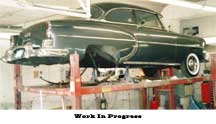 In high school, my car was a 1950 2-door Ford painted black, and had dual exhaust. Two of my classmates had ‘49 Chevies with split exhausts (one of which was done in shop class.) This is when the envy started. How could I make my Ford sound like the Chevies? The answer is: you cannot!
In high school, my car was a 1950 2-door Ford painted black, and had dual exhaust. Two of my classmates had ‘49 Chevies with split exhausts (one of which was done in shop class.) This is when the envy started. How could I make my Ford sound like the Chevies? The answer is: you cannot!
Transportation for the next 45 years consisted of a VW, 3 Chevy wagons, a Nova, a Buick, an Omni, two K-cars, two Tauruses, and a Mercury, before we became a two-car family.
One day while getting gas for our return trip home from South Hadley, MA, we saw a really nice 1954 Chevy 210 2-door with the sweetest sounding pipes. I was hooked again. On another visit to South Hadley, my cousin said that “my” car was for sale and did I want to take a look. Of course I did. Off we went. But the owner wanted too much money. The next time we were in South Hadley was for our 45th high school reunion, Thanksgiving weekend, 1994. My cousin said the Chevy owner wanted to see me; he had become more reasonable. A test drive, a handshake and the deal was made.
The following weekend my son and I went to bring the car home along with a box of some 38 trophies, various moldings, speedometer, a bumper, and several boxes of small parts.
Since owning the Inliner I have made some enhancements. Visually, it has been painted black suede, rims painted red, with caps and rings and whitewall tires. The engine was rebuilt some years ago and mildly modified. The transmission, a Power-glide, was replaced with a TH350 with a shift kit. (Boy, does that car love second gear!) We also replaced the rear end with a ‘57 that came with 3.36 gears.
The first show for the Inliner was the last VAE show at the fairgrounds in Essex. There I met Conception Conti, he signed me up, and gave me a handful of old dash plaques. I have been collecting them ever since.
That same year was our first time at Stowe. As I was heading down the hill looking for my registration number, I heard, “What are you doing with Ray Faginski’s car!?” And that is how I met Barry Rickert, apparently a friend of the man I bought the Inliner from.
Marty and I have become good friends with Barry and Ginny Rickert from Wilbraham, MA. Over the years together we have put many miles on our Stovebolts.
We meet great people who share our interest in the old car hobby!
Editor’s notes….Andy tells me there are over 3000 members in the world wide “Inliner Car Club”. For you folks just learning, like me, the term inliner means the cylinders are inline and not like a v8 or v6. Although in Europe the term inliner can include V configurations. An Inliner can be two, four, six or twelve cylinders but the Chevy inline six engine is where the term resides most of the time.
What does stovebolt mean? Well I asked that too and it seems if you want to tear down a Ford you can do most of it with a 9/16 inch wrench…..but when it comes to Chevies they used half inch ‘bolts’ just like they use to build stoves….you know, with quarter inch slotted bolts and the square nuts. Many non-Chevy folks have some fun with that but mostly there are no smiles on the Chevy guy’s face when the term is used.










